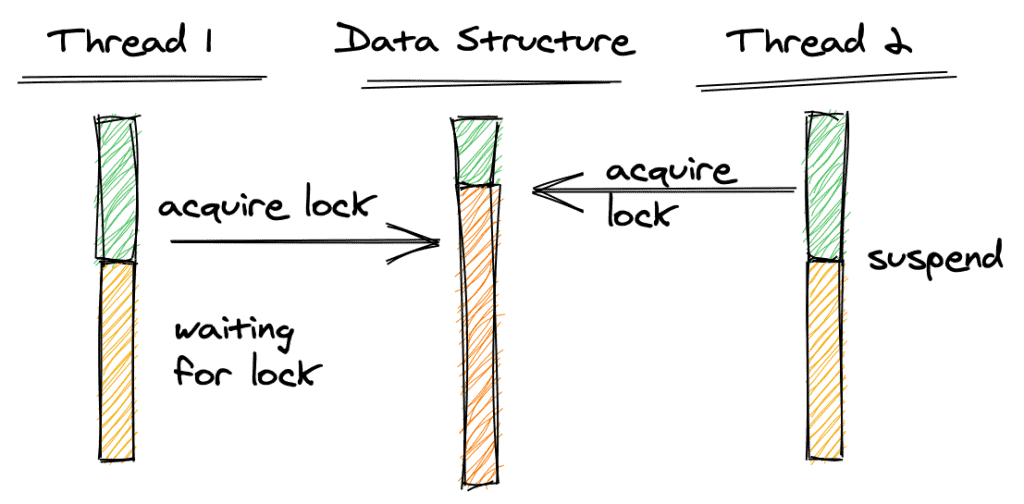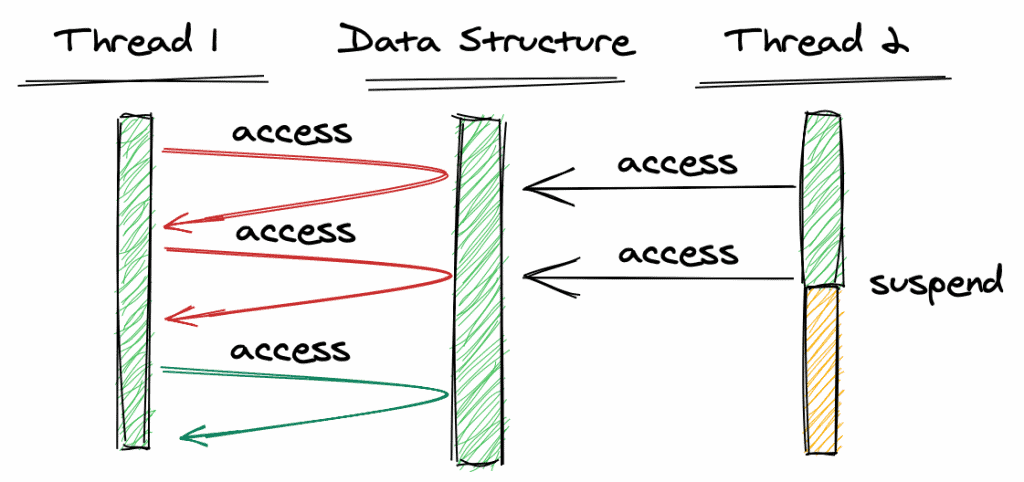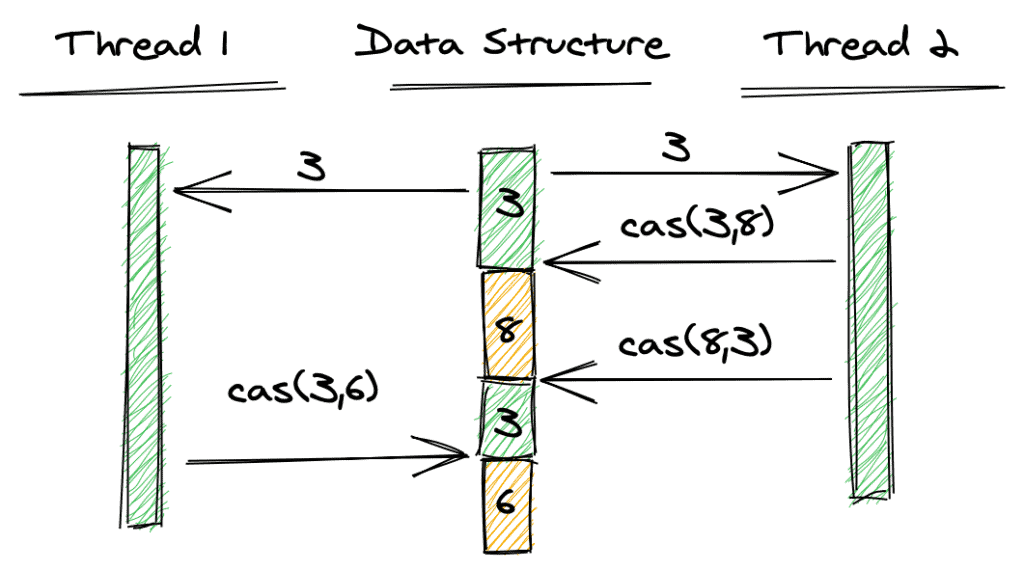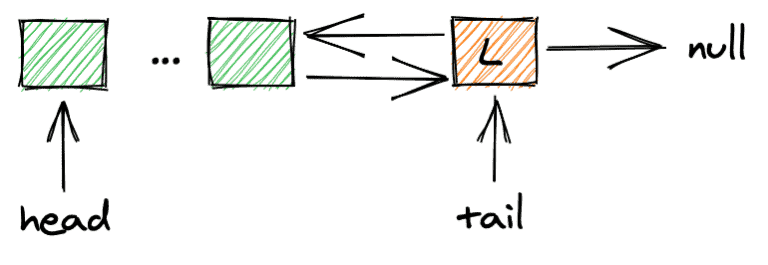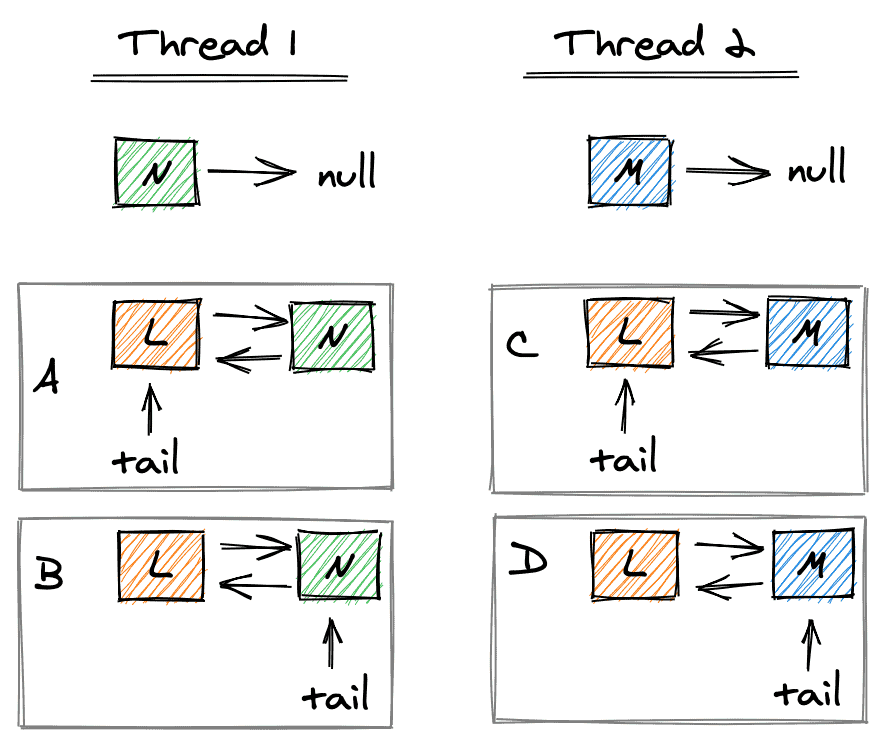1. 引言
本文带你深入理解无锁(lock-free)数据结构的核心原理及其在高并发场景下的优势。相比传统的基于锁的并发容器,无锁结构能有效避免线程阻塞、死锁和优先级反转等问题,是构建高性能并发系统的关键技术之一。
我们将依次讲解以下内容:
- ✅ 无锁相关的术语:obstruction-free、lock-free、wait-free
- ✅ 实现无锁算法的核心原子操作,如 CAS
- ✅ 手写一个简单的 Java 无锁队列
- ✅ 如何向 wait-free 迈进
目标是让你不仅能看懂 JDK 中 ConcurrentLinkedQueue 的设计思想,还能在必要时自己实现或优化类似结构。
2. 锁 vs 饥饿
我们先厘清两个关键概念:阻塞(blocked) 和 饥饿(starvation)。
阻塞线程(Blocked Thread)
看下图:
Thread 2 拿到了数据结构的锁。当 Thread 1 也想获取锁时,它必须等待 Thread 2 释放。⚠️ 如果 Thread 2 被挂起(suspend),Thread 1 将永远等下去 —— 这就是阻塞。
饥饿线程(Starving Thread)
再看无锁情况:
Thread 2 访问数据结构但不加锁。Thread 1 同时尝试访问,检测到冲突后立即返回失败(红色),然后重试,直到成功(绿色)。
✅ 优势:无需锁,避免了死锁和无限等待。
❌ 缺点:如果其他线程频繁操作,Thread 1 可能需要重试很多次才能成功 —— 这就是饥饿。
无锁算法的核心思想是:用“重试”代替“等待”,通过原子操作(如 CAS)实现线程间的协调。
3. 无锁数据结构的三种级别
根据线程进展保证的强弱,可分为三类:
3.1. Obstruction-Free(无障碍)
- ✅ 定义:只要其他所有线程都暂停,当前线程一定能向前推进。
- ⚠️ 最弱保证。现实中很少直接使用,多作为构建更高级别算法的基础。
- 对比锁:如果持有锁的线程挂起,等待者会永久阻塞;而 obstruction-free 不会。
3.2. Lock-Free(无锁)
- ✅ 定义:在任意时刻,至少有一个线程能够成功完成操作并推进。
- ❌ 允许个别线程长时间饥饿,但系统整体必须持续向前(global progress)。
- 这是大多数高性能无锁容器(如
ConcurrentLinkedQueue)的目标级别。
3.3. Wait-Free(免等待)
- ✅ 定义:在 lock-free 基础上,每个线程都能在有限步数内完成操作,彻底避免饥饿。
- ✅ 最强保证,但实现复杂,开销大,实际应用较少。
3.4. 小结对比
- 左:obstruction-free —— 其他线程暂停后,目标线程可推进。
- 中:lock-free —— 即使所有线程都在跑,至少一个能成功。
- 右:wait-free —— 每个线程最终都能成功,不会无限重试。
4. 无锁算法的基石:原子操作
实现无锁结构依赖底层硬件支持的原子指令。Java 通过 sun.misc.Unsafe 和 java.util.concurrent.atomic 包封装了这些能力。
4.1. Compare-and-Swap (CAS)
CAS 是无锁编程的核心原子操作,语义如下:
如果当前值等于预期值,则更新为新值,返回 true;否则不更新,返回 false。
其原子性保证了“读-比-写”三步操作不可分割。
图解:
- 两线程同时读取值为 3。
- Thread 2 CAS 成功,值变为 8。
- Thread 1 的 CAS 失败(预期是 3,实际是 8),需重试。
CAS 代码模拟
volatile int value;
boolean cas(int expectedValue, int newValue) {
if(value == expectedValue) {
value = newValue;
return true;
}
return false;
}
CAS 典型使用模式
void testCas() {
int v = value;
int x = v + 1;
while(!cas(v, x)) {
v = value;
x = v + 1;
}
}
✅ 成功则退出循环;失败则重读最新值,重新计算,再试。
⚠️ 风险:在高竞争下可能陷入长时间重试(饥饿),但系统整体仍在推进(lock-free)。
注意事项
- ✅ Java 推荐使用
AtomicInteger等类,而非直接操作Unsafe。 - ⚠️ CAS 无法解决 A-B-A 问题,见下节。
4.2. Load-Link / Store-Conditional (LL/SC) 与 A-B-A 问题
A-B-A 问题
场景:
- Thread 1 读取值 A (3)。
- Thread 2 将 A 改为 B (8),又改回 A (3)。
- Thread 1 执行 CAS,预期是 A,当前也是 A,于是成功。
问题:Thread 1 无法察觉中间状态的变化。这在指针操作中可能引发严重错误(如访问已释放内存)。
解决方案:LL/SC 或 带版本号的 CAS
Java 提供了 AtomicStampedReference<V>,它不仅存储对象引用,还附带一个整型“戳记”(stamp),每次修改都递增 stamp,从而区分真正的“相同值”。
AtomicStampedReference<String> ref = new AtomicStampedReference<>("A", 0);
// 即使值变回"A",stamp已不同,CAS会失败
4.3. Fetch-and-Add
原子性地对变量进行增减操作。
- ✅
AtomicInteger.getAndIncrement():先返回旧值,再加 1。 - ✅
AtomicInteger.incrementAndGet():先加 1,再返回新值。
这类操作在计数器、ID 生成器中非常高效。
5. 多线程操作链表队列的典型问题
我们以一个双端链表队列为例,理解无锁的必要性。
队列结构如下:
tail 指向尾节点,新元素插入在 tail 之后。
两个线程(T1、T2)同时添加元素 N 和 M,需执行三步:
- 创建新节点。
- 设置前驱(N.prev = L)和后继(L.next = N)。
- 更新
tail指向新节点。
问题场景
- ❌ 若执行序为 ABCD 或 ACBD:T2 的更新覆盖了 T1,导致 N 节点丢失。
- ❌ 若执行序为 ACDB:
tail指向 N,但 L.next 指向 M,队列结构不一致。
传统解法是加锁。而无锁解法,是用 CAS 原子地更新 tail 指针,确保插入的原子性。
6. Java 实现一个无锁队列
下面手写一个简化的无锁队列,帮助你理解核心思想。
核心成员变量
public class NonBlockingQueue<T> {
private final AtomicReference<Node<T>> head, tail;
private final AtomicInteger size;
public NonBlockingQueue() {
head = new AtomicReference<>(null);
tail = new AtomicReference<>(null);
size = new AtomicInteger();
size.set(0);
}
}
- ✅
head和tail使用AtomicReference,保证指针更新是原子的。 - ✅
size使用AtomicInteger,保证计数准确。
节点定义
private class Node<T> {
private volatile T value;
private volatile Node<T> next;
private volatile Node<T> previous;
public Node(T value) {
this.value = value;
this.next = null;
}
// getters and setters
}
- ✅ 所有引用标记为
volatile,确保内存可见性。
6.1. 无锁 add 操作
public void add(T element) {
if (element == null) {
throw new NullPointerException();
}
Node<T> node = new Node<>(element);
Node<T> currentTail;
do {
currentTail = tail.get();
node.setPrevious(currentTail);
} while(!tail.compareAndSet(currentTail, node)); // CAS 更新 tail
if(node.previous != null) {
node.previous.next = node; // 链接前驱的 next
}
head.compareAndSet(null, node); // 首元素特殊处理
size.incrementAndGet();
}
✅ 核心逻辑:
- 循环尝试用 CAS 将
tail从currentTail更新为node。 - 只有当
tail没被其他线程修改时,CAS 才成功,确保了插入的原子性。 - 成功后,再修补
previous.next指针(非原子,但安全,因为只有本线程能修改node.previous)。
⚠️ 踩坑点:先更新 tail 再设置 previous.next,避免其他线程看到一个 tail 指向但未完全链接的节点。
6.2. 无锁 get 操作
public T get() {
if(head.get() == null) {
throw new NoSuchElementException();
}
Node<T> currentHead;
Node<T> nextNode;
do {
currentHead = head.get();
nextNode = currentHead.getNext();
} while(!head.compareAndSet(currentHead, nextNode)); // CAS 更新 head
size.decrementAndGet();
return currentHead.getValue();
}
✅ 核心逻辑:
- 循环尝试用 CAS 将
head从currentHead更新为nextNode。 - 成功则移除头节点并返回其值。
现实中的实现
- ✅ JDK 的
ConcurrentLinkedQueue就是基于 Michael & Scott 算法的 lock-free 队列。 - ⚠️ 有趣的是,早期文档称其为 wait-free,实则为 lock-free。Java 8 起已修正为 lock-free。
7. 如何实现 Wait-Free 队列
前述实现是 lock-free 的,add 和 get 中的 while 循环在高并发下可能重试很多次。
Wait-Free 的挑战
- ✅ 要求每个线程在有限步内必成功。
- ❌ 不能依赖“重试”,必须有确定性进展。
基本思路:Helper Threads(辅助线程)
一种经典思路是为每个线程分配一个“助手”:
- 当线程 A 想入队,但一直失败。
- 助手线程 B 成功入队后,必须先帮 A 完成入队,才能处理自己的请求。
- B 也有自己的助手 C,C 也会帮 B,依此类推。
✅ 保证:在最坏情况下,A 的操作会在所有线程各成功一次后完成。
⚠️ 实现复杂:需动态管理线程关系,处理线程退出等边界情况。实际应用中,lock-free 通常已足够。
8. 总结
- ✅ 无锁结构通过 CAS 等原子操作,用“重试”替代“阻塞”,提升并发性能。
- ✅ 三级别:obstruction-free < lock-free < wait-free,实践中 lock-free 最常用。
- ✅
ConcurrentLinkedQueue是典型的 lock-free 队列,理解其原理对掌握并发编程至关重要。 - ✅ A-B-A 问题需警惕,可用
AtomicStampedReference解决。 - ⚠️ wait-free 虽理想,但实现复杂,多数场景 lock-free 即可。
本文完整代码示例已托管至 GitHub:https://github.com/yourname/concurrent-examples
